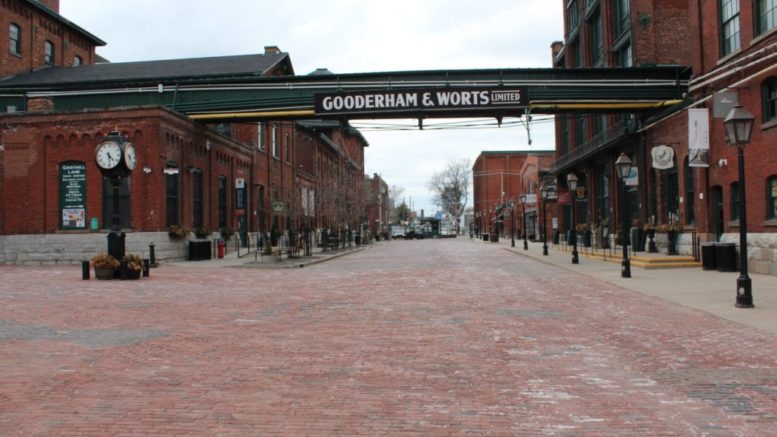The quaint, cobblestone streets of Toronto’s Distillery District are usually packed with art lovers, whiskey connoisseurs, fashionistas and foodies. But as the coronavirus lockdown continues, they now appear abandoned.
The rare passerby walks with urgency on a mission to pick up essentials, but the laneways are otherwise empty.
The scope of the COVID-19 crisis is constantly shifting, but it’s closed Toronto’s restaurants for the foreseeable future. On April 9, Prime Minister Justin Trudeau discussed the reality of “the new normal” in Canada, saying the effects would last for more than a year.
Activity in the restaurant scene is sparse and displays a massive juxtaposition from one month ago. Hot spots that required a reservation a month in advance with dining rooms filled of groups breaking bread and clinking wine glasses are now empty with condolence letters posted on the front doors.
The “new normal” may bring some diners back to restaurants, but it’s also possible Toronto’s food scene will never be quite the same.

Due to the expected waves of the outbreak that will occur after the first wave has passed, “people will be more encouraged to order delivery and take-out and perhaps this service will be enhanced in some way,” said Roberto Restrepo, assistant general manager of Rosalinda, a downtown restaurant. “For example, maybe the packaging will be a reflection of what the restaurant is like. There are so many possibilities.”
How Toronto’s restaurants are coping with the pandemic:
Many restaurants have moved to delivery and takeout while their dining rooms are closed. However, this model presents a further series of obstacles. Firstly, many of them are new to the game and have not run such services before.
“In fine dining restaurants, guests typically spend a of couple hundred dollars for a multi-course tasting menu that is accompanied by wine and cocktails. The dining room is a massive part of income that has been shut off, thus restaurants have seen a huge plummet in their revenue,” explained Toronto Star food reporter Karon Liu.
“Where they are used to making a couple hundred dollars per table is now down to $65.00 per person with delivery at best. There is a huge decline.”

Secondly, people are cooking more at home now and are making the choice to spend less as there is financial uncertainty in all sectors as the country faces a recession.
“Everyday I’ve been talking to restaurants, suppliers and farmers about what they anticipate is going to happen in the next month, and they explained that they are just trying to figure out what is going to happen tomorrow,” said Liu.
The challenge is the time between then and now. As time continues, rent and expenses accumulate.
“In a best-case scenario, a restaurant can realistically pull 20 per cent revenue from take-out and delivery, so that is one fifth of their normal sales. Therefore, everyday running at one fifth of capacity will take at least five days to recover from. This adds up quickly,” explains financial professional Shay D’Souza.
Businesses may have the option to defer a payment, but it is only a matter of time before the next payment is due. Landlords hold a unique grasp on the market — regardless of the state of market they expect a consistent return; after all, the landlords are not large businesses either.
“This creates a huge ripple effect, and small businesses will not be able to keep this up for very long. It is a race against time,” says D’Souza.
Sadly, restaurants close when they face challenges — especially small independent businesses.
“There are some parts of town that are overloaded with small bars and restaurants. They can’t all survive,” said Pal Di Iulio, editor at Panoram, an Italian-Canadian cultural Magazine.
“There is a natural selection that is sometimes thrust upon us like this particular challenge and people will have to reinvent themselves.”

Now that society sees the ripple effect occurring in the hospitality realm, Liu expresses the hope that people will rationale in paying a few extra dollars for a dish understanding that it will provide the person making it a stable life in dire times.
“The restaurant system has always been broken. After this, what I hope happens is a revaluation of the restaurant model to make sure that it can be a business that is run with higher profit margins where employees will have enough money to whether a storm like this, if and when a pandemic happens again,” said Liu.
“It’s a huge ecosystem of changes that will hopefully be made from the customer level and up to the government level.”
According to SaveHospitalityCA, a campaign organized by Canadian restaurant owners to save their businesses, food service is a $90-billion industry in Canada. Restuarants are the country’s fourth-largest employer. With 1.3 million jobs, they comprise seven per cent of the workforce.
Since there is no clear path of what will happen next during these uncertain times, the campaign has proposed industry-specific steps to support the hospitality industry and avoid complete collapse.
SaveHospitalityCA’s proposal includes the following recommendations:
- Supplemented EI benefits for workers in large cities where the cost of living is higher than other parts of the country
- Providing forgivable loans to restaurants to allow them to pay rent, cover bank interest, guarantee benefits for laid off employees and ensure enough capital to restart their businesses
- The structuring of these loans would add security to the banking systems and real estate markets, while allowing restaurants to bring back their workers and pay suppliers without the crush of un-survivable debt
With a sustainable action plan supported by the government, the restaurant industry may be able to recover from the pandemic and meet the wants and needs of consumers once the pandemic passes.
The silver lining here is that restaurants and businesses owners now have the time to consider how they want to reinvent their brand to meet a world post COVID-19. Perhaps the appetite of the new world will pang for something new.

